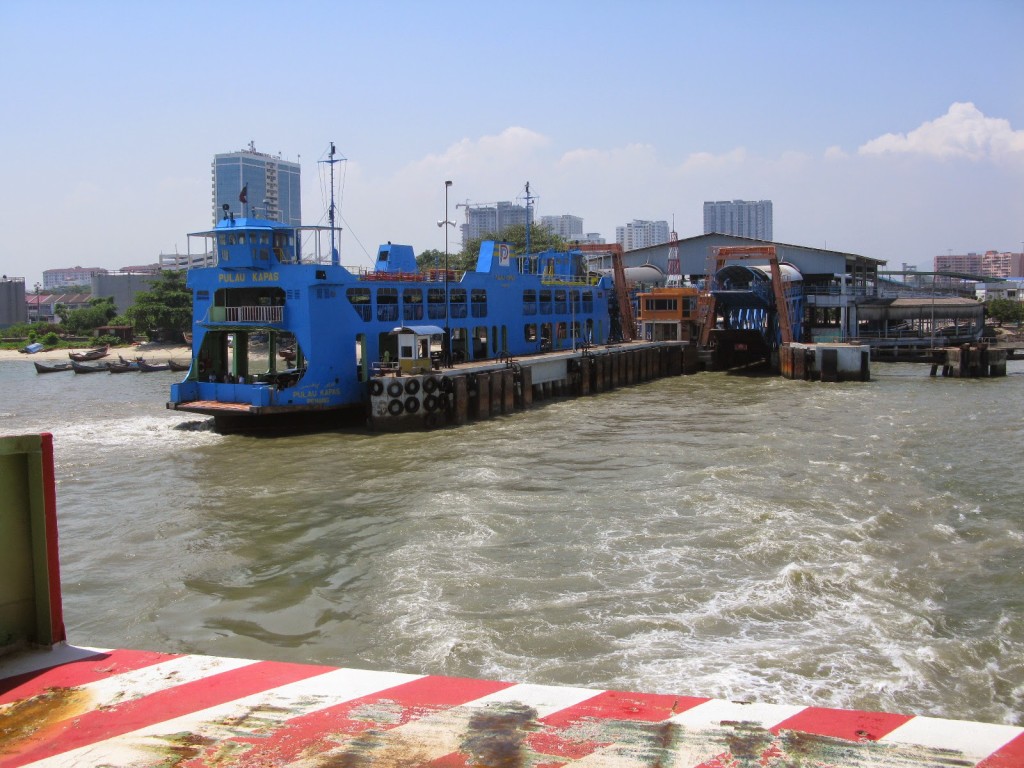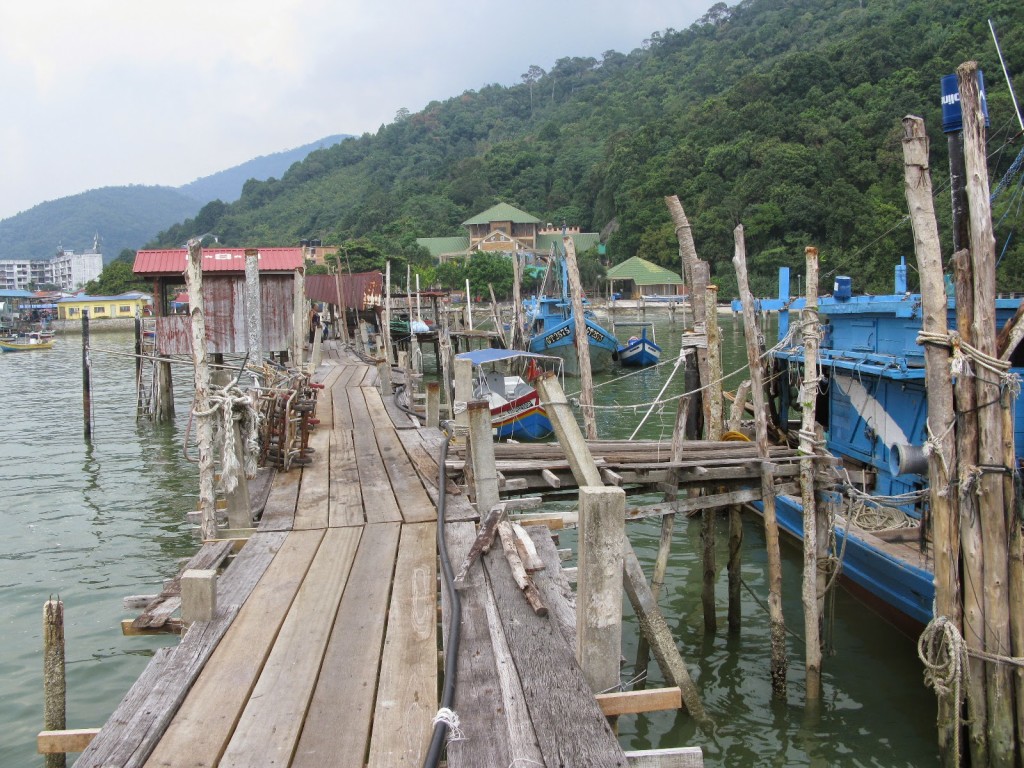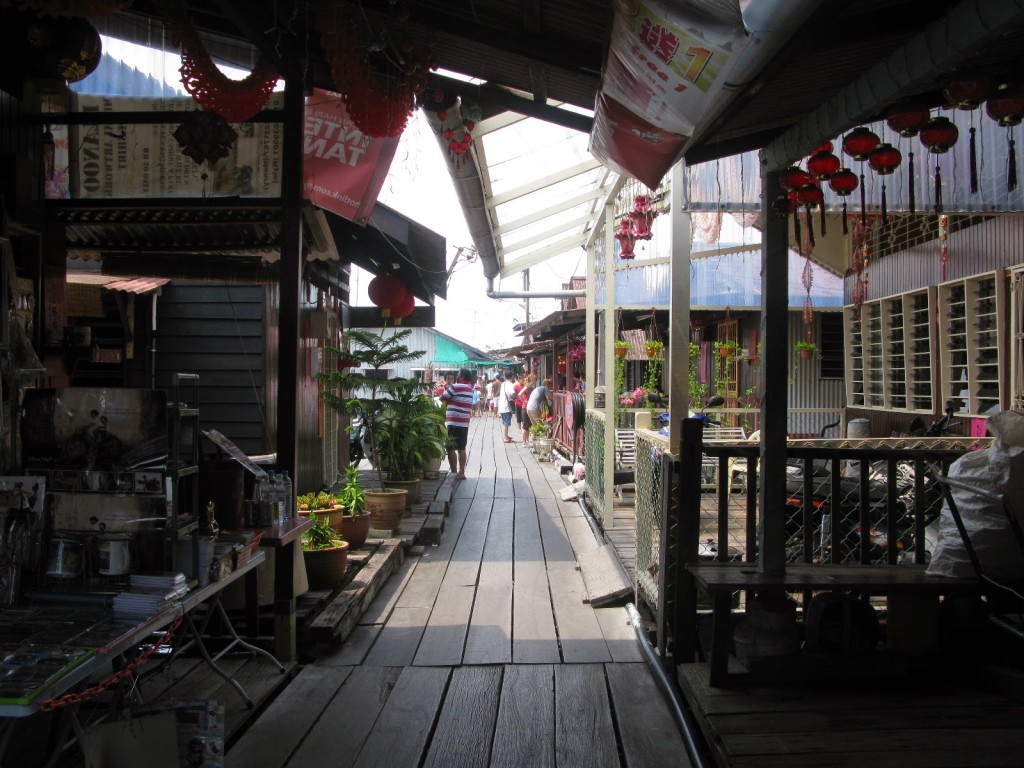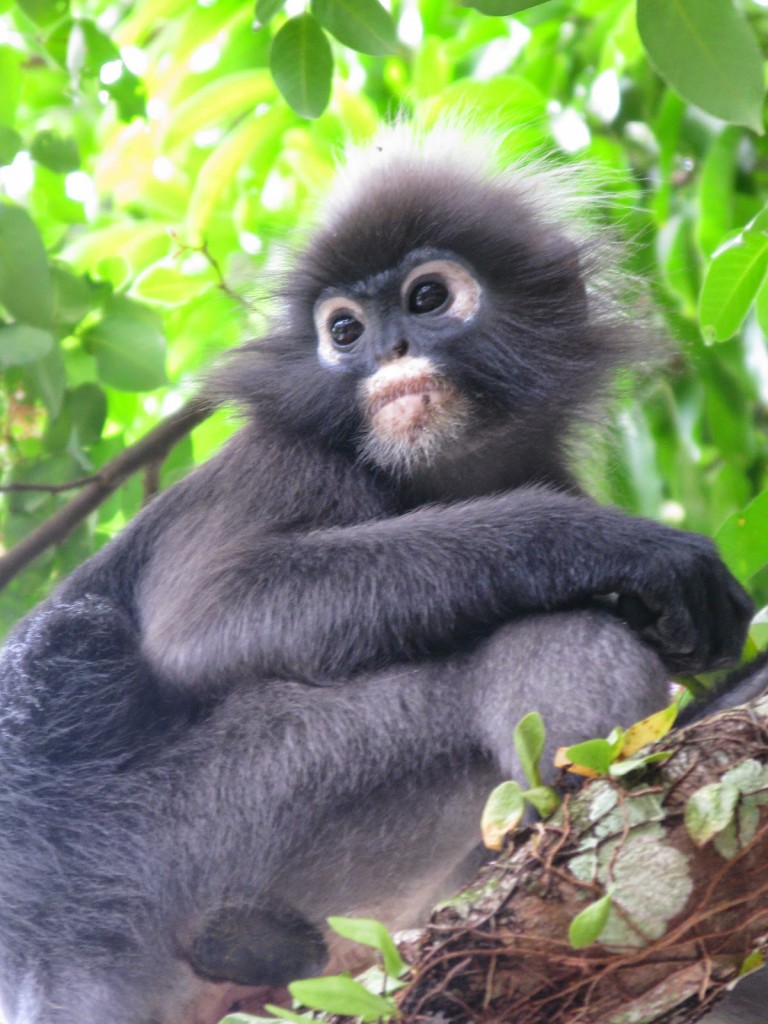There are actually two road bridges linking the island of Penang with the mainland, but we had been advised by the bus company that if our destination was George Town, Penang’s capital, we would do better to get off at Butterworth and take the ferry as the journey from the bus’s terminus out near Penang airport would be inconvenient. We obeyed, following the majority of our fellow passengers upstairs and out of Butterworth bus station. There was then a slightly confusing requirement to go to a cash desk to swap modern Malaysian coins for obsolete ones in order to put 30p’s worth into a ‘turnstile’ which lacked an actual mechanism, under the supervision of another employee. I have no idea why they couldn’t just sell tickets or collect money as people passed by the cash desk.
The Penang-Butterworth ferry would certainly not win a beauty competition – it looks like something built from meccano. Motorbikes go on the bottom deck, and passengers on the upper with cars along the outside edges. Three boats, two blue and one orange, ply to and fro across the straight just as fast as they can, so we didn’t have to wait long to make the 15 minute crossing between Butterworth’s busy docks and the high rise blocks of George Town’s financial area. In the distance we could see one of the road bridges through the haze – an impressive structure snaking low across the calm grey water. On the other side we had our first experience of Penang’s cheap and efficient bus service, finding our required 101 bus waiting at the bus station next to the ferry terminus. It took a while to get to grips with the routes, especially that of the free central area bus that meanders all over George Town, but once we did we used them frequently.
Penang had long been on my ‘must visit’ list and I thought we might want to spend some time by the sea there, but an excursion along the north coast quickly squashed that idea. We took the 101 to the end of its route, the national park at the north west tip of the island. On a cooler day, and if we hadn’t previously spent time in a tropical rainforest, we might have felt inclined to enter the park and tackle one of the paths through the steep hills behind the entrance. Instead we contented outselves with a wander around the waterfront where rickety wooden fishing piers jutted over very uninviting water. The scruffy beach at neighbouring Teluk Bahang was quickly crossed off the list of possible places to stay.
Penang’s main beach resort is Batu Ferrengi, half way along the north coast. It hadn’t made a great impression on our way through, and it appealed no more on the way back. The sea looked murky, the sand third rate, and overall it looked slightly tacky, so we stayed on the bus back to George Town and resolved to push on to Thailand.
It had proved impossible to find out how far ahead train tickets needed to be booked, since the trains to Thailand can’t be booked online. Having tried unsuccessfully to find a travel agent in George Town who would book train tickets we were preparing for a ferry trip to Butterworth station, when I found a single reference online to a railway booking office at the Penang ferry terminal. Sure enough, there it was, and tickets were available for whenever we wanted, even the next day if we liked. Since we didn’t actually have a Thai visa at that stage, and a border visa waiver would only give us 30 days in Thailand, we opted for the following Wednesday. That would give us four days to get a visa and finish exploring George Town, which was beginning to grow on me with its clan jetties, shophouses and Chinese temples mixed with white colonial buildings, sprinkling of mosques, and a raucous Little India with Hindi (or Tamil?) pop blaring out of every other shop.
One of Penang’s main draws is a Thai embassy, whose location close to the end of the Bangkok-Butterworth train line makes it a magnet for foreigners who push the boundaries of Thailand’s immigration rules by undertaking regular visa runs to neighbouring countries. A well organised industry has grown up to assist them, involving deals between hotels and visa agents in Penang, and minibus companies in southern Thailand. Their days may be numbered though – the new military rulers of Thailand have moved to crack down on foreigners who linger too long without good reason, placing a limit on the number of times a border visa waiver will be granted. The expectation is that successive visa applications will also come under scrutiny. For now though, getting a 60 day Thai visa (which can be extended for another 30 days) in Penang is a simple affair with no need to engage an agent, although it did require two bus trips out to the suburbs of George Town and a bit more hanging around than anybody could really enjoy. At least we had the antics of a Silver Leaf Langur to entertain us as it raided the starfruit trees outside the embassy. We’d taken the precaution of dressing reasonably smartly (well, as smart as is possible given our extremely limited wardrobes) as is usually advisable when dealing with embassies of countries that you hope will allow you admittance. We needn’t have bothered – even in our tattiest gear we would have looked like the most desirable of visitors compared with the dipsy, shoeless, away-with-the-fairies American girl who was evidently working at a dive resort somewhere in Thailand, probably illegally. And yet the only people given a hard time were Africans renewing their work visas, queueing quietly and dressed to a standard that shamed us all.
All that remained then was to get some Thai money, since we didn’t want to be at the mercy of a border currency exchange office. I was a bit sorry to be leaving Malaysia only 3 days before the start of Ramadan. Although I think staying for the whole thing would have been a hassle (although probably less so on Penang than some other places in Malaysia), it would have been interesting to experience it for a few days.
The journey back to Butterworth went smoothly enough, but then there was a long and slightly confusing trek through walkways and over bridges to get to the newly built railway station. At least the ticket office cum waiting room was air conditioned, so the train’s tardiness (40 mins) wasn’t too awful. With only 2 carriages it didn’t really look like an International Express though, but it seemed relatively clean and modern. Our train seats were wide, as we knew they would be, but luggage storage was an issue – no racks, and not enough space to push our backpacks under the seats. Whoever slept on the wide bottom bunk was going to have to share with the bags.
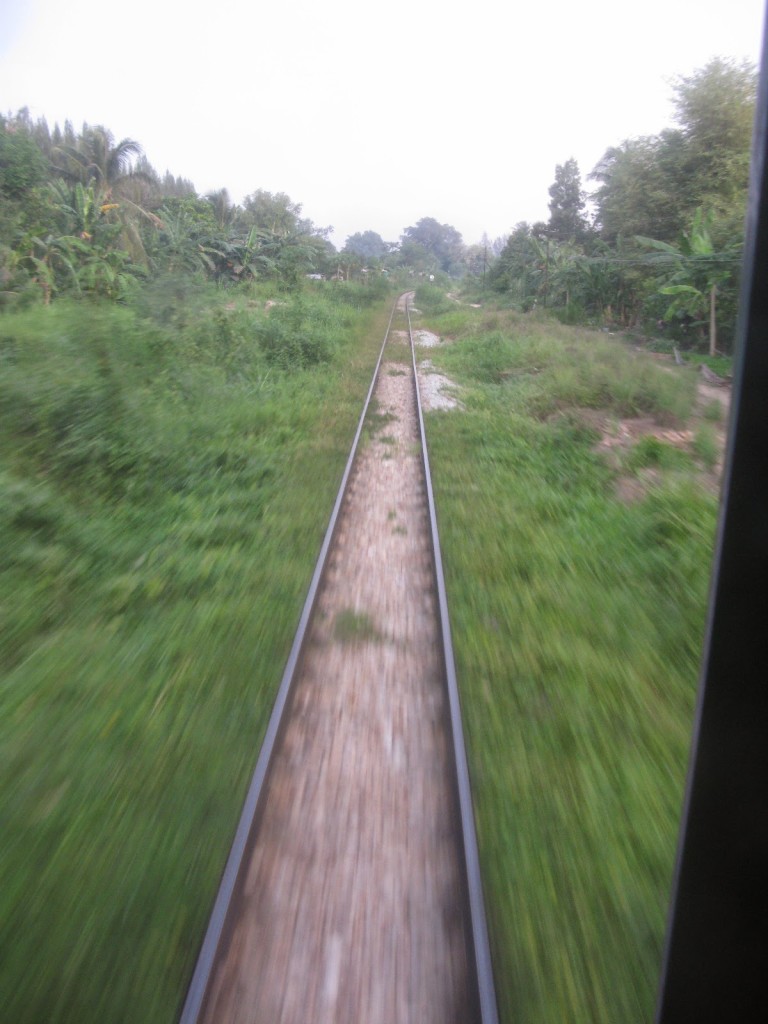
The railway track on the Thai side of the border – this is the main international line that links Bangkok with Singapore
The journey was uneventful. Several times we had a fit of the giggles at a young American backpacker a few rows away who had been talking non stop about food since we left Butterworth, primarily fruit, and durians in particular. I mean, I know durians are among the more interesting fruits, but this guy went on and on for 4 hours. Just when we thought he had exhausted the topic, he would remember a dream he had about eating durians, and off he went again.
At 7pm we reached the Thai border and the crossing was relatively organised. We all got off, leaving our luggage on board, walked through the Malay customs, across the border, through Thai customs, and got back on the train which had pulled forward to meet us. The Indian guy who was sitting across the corridor from us got back on the train and started to colect up his belongings – he had planned to get a visa waiver at he border but had forgotten to bring the required photos – he was going to have to spent the night in Padang Besar and get photos the next day. As soon as we were back on board dinner was served (rice and chicken for me, vegetables for Al, along with a bottle of beer – very civilised. Once in Thailand the track immediately became bumpier, and tangled vegetation pressed in on either side. The attendant came round to lower the top bunks and make up the beds, after which we had little choice but to retire. Getting up on the top bunk involved a bit of contortionism to squeeze into the narrow bed under a low roof, and the bumpy track, clumsy shunting (at Hat Yai, where extra carriages were added), and bright carriage lights which shone over the top of my curtain all combined to ensure that I got very little sleep. But to give Thai railways their due, we pulled into Hua Hin at dawn, dead on time.


